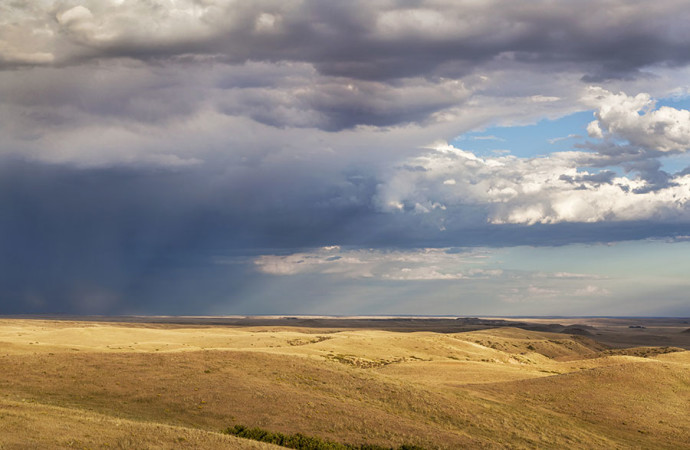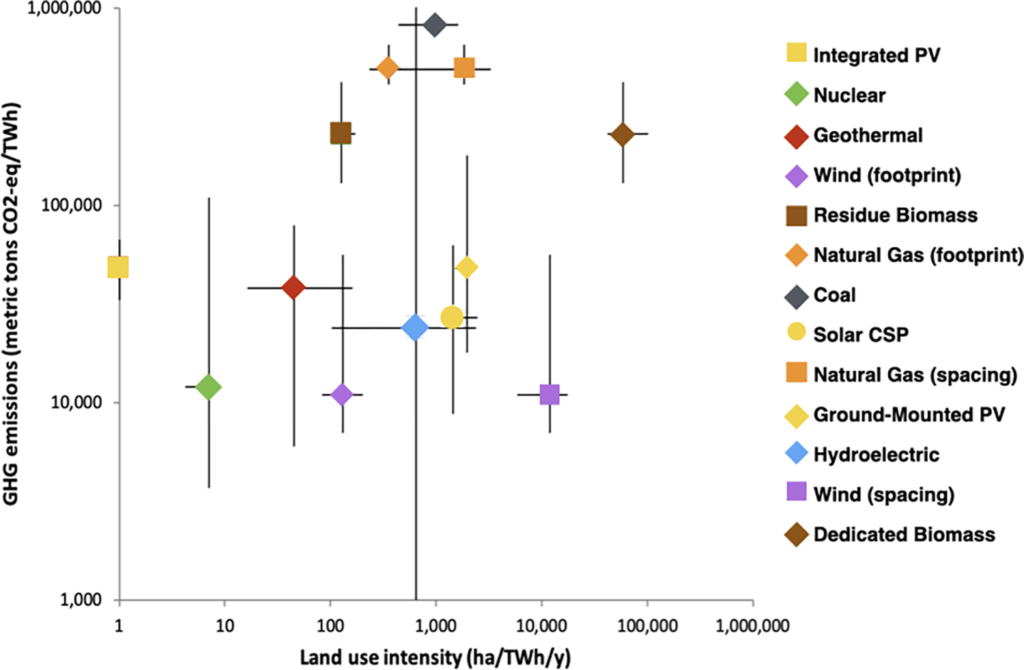Much of the conversation surrounding energy policy in Colorado these days has to do primarily with the emissions currently being produced and ways to continue reducing said emissions. The arguments over the role of various energy sources in getting to a decarbonized future are familiar at this point.
But there has been comparatively little discussion over the impact of that future on the state’s land-use.
It’s an underappreciated component of supplying energy, as the environmental impacts of a given resource extend far beyond atmospheric emissions. In order to function at scale, every resource from hydropower to natural gas requires land to generate effectively. That means taking land that would otherwise be used for some other purpose and devoting it to procuring energy for the state’s residents.
In other words, there’s a trade-off being made each time a new power station is built, and an opportunity cost incurred for the land being used in the generation process.
So how does each energy resource stack up on this front? And how can Colorado pursue an energy portfolio that is sufficiently concerned with the tradeoffs between decarbonization, reliability, AND efficient land use?
What the Data Show
A new paper from researchers Jessica Lovering, Marian Swain, Linus Blomqvist, and Rebecca R. Hernandez published in the journal PLoS One calculates the land-use intensity of energy (LUIE) of real-world generation sites for all major sources of electricity.
The researchers compared both the immediate footprint of a given resource—such as the land area of an individual wind turbine pad and its access road—as well as the total area within the perimeter of a full production site. The land area needed for the upstream production of fuel was also included for resources requiring fuel inputs (e.g. a coal plant).
The researchers then compared each electricity source based on the hectares of land occupied per terawatt-hour of electricity generated in a given year (ha/TWh/y). What they found was that nuclear power had the lowest median land-use intensity of any electricity generating resource capable of operating at scale, coming in at 7.1 ha/TWh/year.
For comparison, the researchers found that the median footprint of wind with spacing included is 12,000 ha/TWh/year and 2,000 for ground-mounted solar arrays. Fossil fuels ranged from 410 ha/TWh/year for natural gas to 1,000 for coal.

Land use intensity of electricity / in PLoS ONE: Jessica Lovering, Marian Swain, Linus Blomqvist, and Rebecca R. Hernandez
When each resource’s greenhouse gas (GHG) footprint is included in the analysis, nuclear power again shines above the rest, coming in second only to rooftop solar in terms of land use intensity while still producing some of the fewest lifecycle GHG emissions of any electricity source.
And because there are inherent limits to how much onsite rooftop solar can scale up (there are only so many roofs on which to build), nuclear truly represents the only viable low-carbon, low-land use option for supplying mass amounts of energy to a large population.
Why Land Matters
The research provides key insight into what should be a major consideration as governments across the world continue to pledge enormous buildouts of renewable energy to meet lofty decarbonization goals by mid-century.
With those renewable pledges also comes an inchoate pledge to use up vast swaths of open space otherwise available for forest preservation and restoration, croplands for farming, pastureland for grazing livestock, future residential/commercial development, and outdoor recreation.
To put it into perspective at the macro-level, researchers at Princeton University have estimated that in order to meet President Biden’s goal of a carbon-free economy run on renewables by 2050, it would require land five times the area of South Dakota in order to build out the requisite solar and wind projects.
Here in Colorado, policymakers spearheaded by Governor Jared Polis have set a goal of complete decarbonization in the state through renewables a full decade earlier, by 2040.
That will require converting an immense amount of open space into utility scale solar and wind projects in a relatively rapid time span. It also assumes that Coloradans will be on board with our state’s breathtaking mountain vistas being overtaken by sprawling arrays of black polysilicon panels and immense steel turbines.
Here, China offers a glimpse of what that future might look like:
https://twitter.com/KalPatel/status/1487878993244217344?s=20&t=Wluc_ENJx9H-wFZ3ExzZsA
Energy NIMBYism
To be clear, this is not a call for an embrace of NIMBY (not-in-my-backyard) impulses, which in many cases can be quite harmful to efficient and desperately needed development (see housing crisis).
But it is simply an acknowledgment of a political reality: people may express support for an idea in concept—such as an unprecedented build out of distributed renewable energy generation—but end up fighting it tooth and nail once they realize practical implications of such a build out on the natural landscape, wildlife biodiversity, or other downstream concerns that they might care about. This goes double for a state like Colorado where residents understandably care very deeply about the natural beauty, wildlife, and outdoor recreational activities available in the state.
Even the ostensibly climate-concerned have embraced NIMBYism on several occasions to halt renewable energy projects in order to preserve landscapes and protect species biodiversity.
In acknowledgment of this fact of human nature, a proper cost-benefit analysis would consider future land-use requirements in the process of resource planning for a state looking to undergo an “energy transition” as it grows in population.
In completing such an analysis, nuclear’s land-use advantages, combined with its emissions-free ability to produce electricity 24-hours a day, would reveal it to be a prime candidate for a state concerned with a decarbonized future.
Boosting nuclear’s case in this instance are innovative new companies such as NuScale, Oklo, TerraPower, and Rolls Royce who are continuing to develop scaled-down nuclear reactors with even more promise on the space efficiency front.
A successful showing from these advanced nuclear entrepreneurs could pave the way for an enormous deployment of reliable emissions-free electricity with a tiny footprint.
And because of nuclear power’s superior energy density and siting flexibility, there will be less of a need for new transmission line build outs—projects that often come with their own share of NIMBY resistance—in order to get large amounts of generated power to where it is used.
This is especially the case with the next-generation advanced nuclear technology, such as small-modular reactors, which in many cases can be integrated directly into retiring fossil fuel plants to make use of existing transmission infrastructure.
Nuclear’s Upshot
None of this is to say that future nuclear plants would not be met with similar opposition from NIMBY-preservationist impulses. Indeed, a plan to replace the retiring Comanche 3 coal plant in Pueblo with SMR technology was scuttled by NIMBY backlash from local residents earlier this year.
And though there have been some promising trends in terms of public acceptance, a divide still exists along political lines when it comes to attitudes toward nuclear power, creating another potential source of local opposition in more partisan communities.
According to a May 2022 survey from Gallup:
Currently, 39% of Democrats versus 60% of Republicans and 53% of independents favor nuclear energy. The 21-percentage-point gap between Republicans and Democrats is similar to the average for the past two decades…
- Sixty-three percent of men versus 39% of women are in favor of using nuclear energy for electricity.
- Support by education ranges from 57% of college graduates to 50% of those with some college experience and 45% of those with no college.
- A 57% majority of adults 55 and older favor nuclear energy, compared with half of 18- to 34-year-olds and 45% of those aged 35 to 54.
But a lower land use intensity for nuclear combined with the amount of energy its capable of producing makes those battles fewer and farther in between compared to more land-extensive resources. According to the U.S. Department of Energy, a single typical commercial nuclear reactor produces as much electricity as over 3 million solar panels or more than 430 wind turbines, even without accounting for capacity factor (where nuclear also excels).
Prudent planning for a growing state’s energy future is a difficult undertaking. As with most policy considerations, there are no solutions. There are only tradeoffs. But a full accounting of the relevant tradeoffs cannot be made until land-use is just as central to the debate over Colorado’s future energy mix as other concerns like emissions, operating costs, material inputs, etc.
And on that variable at least, there truly is no competition for nuclear when it comes to achieving zero-carbon, baseload power with only a modest physical footprint.









